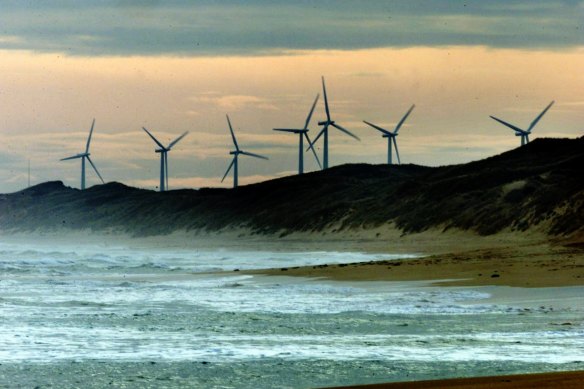This was published 1 year ago
Australia in a ‘sweet spot’ to benefit from clean energy transition, say researchers
The world is not on track to limit the rise in global warming to 1.5 degrees celsius and meet the goals of the Paris Agreement, a global energy consultancy has warned, with everything now riding on actions taken this decade and a $US2.7 trillion ($4.2 trillion) annual spending boost to achieve net-zero by 2050.
Energy research consultants Wood Mackenzie said the world is on a 2.5-degree warming trajectory under today’s policy settings – even when factoring in a steady advancement of low-carbon technologies like wind, solar and green hydrogen power.

No major country is on track to meet their 2030 emissions reduction goals, let alone net-zero.Credit: Joe Armao
“Achieving a 1.5 degrees pathway is going to be extremely challenging, but it is possible. Much depends on the actions taken this decade,” Wood Mackenzie chairman and chief analyst Simon Flowers said.
The firm’s latest Energy Transition Outlook says electricity will quickly become the largest energy market in the world as growth in power demand doubles every five years under a 2.5 degree warming trajectory and triples every 10 years if the world manages to ramp up its decarbonisation.
Australia, close to key markets like Japan and South Korea, is in a “sweet spot” to take advantage of rising demand by supplying low carbon energy and resources while also changing the mix of its exports and decarbonising its own economy, the respected consultancy said.
Flowers said huge global investment over the next 25 years in low-emission technology and a speedy rollout of infrastructure to connect renewables to the grid, as well as a global carbon price to hasten the transition of difficult-to-abate, carbon-intensive industries such as steel, cement and chemicals was needed to curb planet-heating greenhouse gas emissions and help arrest climate change.
“The net-zero pathway was never going to be easy. But the war in Ukraine is underlying the extent to which the global economy still depends on fossil fuels for energy security,” Flowers said, adding that global cooperation was key to driving innovation and technology development.
Oil, gas and coal today account for about 80 per cent of the world’s energy needs and demand has grown fast, bouncing strongly from pandemic lows as countries scrambled to secure alternative supplies after major producer Russia’s war in Ukraine led to US and European sanctions, sparking inflation and record high fossil fuel prices.
The supply of low carbon energy has grown by a third since 2015, but the world’s energy demand has grown much faster due to rising incomes and population growth.
Net-zero pledges now cover 88 per cent of annual global emissions, but no major country is on track to meet their 2030 emissions reduction goals, let alone net-zero. Only Europe and the UK have come close.
“Solar and wind capacity addition could grow from about 200 gigawatts today to almost 15 to 20,000 gigawatts by around 2050,” said the report’s lead author, Prakash Sharma. Australia’s largest coal burning power station, Loy Yang in Victoria, produces about 2 gigawatts and supplies a third of the state’s electricity.
Wood Mackenzie predicts oil and gas consumption will peak in the next 10 to 15 years, but if net-zero targets are achieved, demand could fall as low as 30 million barrels a day and peak “this year or the next”, Sharma said. The world consumed about 100 million barrels a day last year.
The International Energy Agency – the world’s leading energy watchdog – is projecting that oil, natural gas and coal use will peak before 2030, sparking “the beginning of the end” of the fossil fuel era as rapid growth in renewable energy and the uptake of electric vehicles begins to take over.
The agency’s head, Fatih Birol, told the Financial Times newspaper this week that governments must do more to speed up the energy transition and reduce emissions despite backlash in the midst of a cost of living crisis.
“We are witnessing the beginning of the end of the fossil fuel era and we have to prepare ourselves for the next era,” Birol said.
Sharma said gas will play a critical role in the energy transition as China, India and other Asian countries decarbonise. China accounts for nearly 30 per cent of global emissions.
“The biggest challenge for China will be to move away from coal and that’s where the role of gas becomes very important,” Sharma said.
The Business Briefing newsletter delivers major stories, exclusive coverage and expert opinion. Sign up to get it every weekday morning.